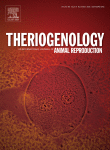Ver ítem
- xmlui.general.dspace_homeCentros Regionales y EEAsCentro Regional Buenos Aires SurEEA BalcarceArtículos científicosxmlui.ArtifactBrowser.ItemViewer.trail
- Inicio
- Centros Regionales y EEAs
- Centro Regional Buenos Aires Sur
- EEA Balcarce
- Artículos científicos
- Ver ítem
Interaction of bovine viral diarrhea virus with bovine cumulus–oocyte complex during IVM: Detection in permissive cells
Resumen
Structural changes in the zona pellucida (ZP) of bovine oocytes seem to modulate their interaction with various viral agents, facilitating the viral infection in in vitro production systems. To evaluate the susceptibility of bovine oocytes to noncytopathogenic bovine viral diarrhea virus (ncp-BVDV), cumulus–oocyte complexes were exposed to 107 tissue culture-infective doses (TCID50)/mL of an ncp-BVDV strain during IVM (in vitro maturation). After that,
[ver mas...]
Structural changes in the zona pellucida (ZP) of bovine oocytes seem to modulate their interaction with various viral agents, facilitating the viral infection in in vitro production systems. To evaluate the susceptibility of bovine oocytes to noncytopathogenic bovine viral diarrhea virus (ncp-BVDV), cumulus–oocyte complexes were exposed to 107 tissue culture-infective doses (TCID50)/mL of an ncp-BVDV strain during IVM (in vitro maturation). After that, cumulus cells and the ZP were removed by hyaluronidase and pronase treatment, respectively, and the percentages of oocytes with polar body were analyzed as a sign of nuclear maturation. After passage through cell culture, the virus was isolated from granulosa cells, ZP-free mature oocytes, and ZP-intact mature oocytes. These results were confirmed by reverse transcription–polymerase chain reaction. After consecutive washes, the virus remained associated with ZP-free oocytes, maintaining its replication and infectivity in permissive cells. Based on these findings, it is concluded that the classical viral isolation procedure has a predictive value to detect BVDV associated with ZP-free oocytes and that it was novelty demonstrated that both washing and trypsin treatment of oocytes were ineffective to remove BVDV infection.
[Cerrar]

Fuente
Theriogenology 86 (8) : 1999-2003 (November 2016)
Fecha
2016-11
Editorial
Elsevier
ISSN
0093-691X
1879-3231
1879-3231
Formato
pdf
Tipo de documento
artículo
Palabras Claves
Derechos de acceso
Restringido
 Excepto donde se diga explicitamente, este item se publica bajo la siguiente descripción: Creative Commons Attribution-NonCommercial-ShareAlike 2.5 Unported (CC BY-NC-SA 2.5)
Excepto donde se diga explicitamente, este item se publica bajo la siguiente descripción: Creative Commons Attribution-NonCommercial-ShareAlike 2.5 Unported (CC BY-NC-SA 2.5)

